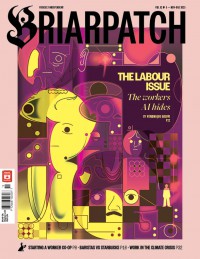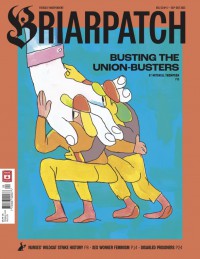
Saskatchewan rising
In our special focus on Canada’s most red hot (and easiest to draw) province, “Saskatchewan Rising: Dispatches from Canada’s Crucible,” Briarpatch sails a prairie schooner through a city of charlatans, assesses the folly of bargain-basement resource royalty rates, speaks with Naomi Klein about what the Left can and should do in the midst of yet another crisis, and celebrates the work of activists and visionaries building the foundation of a sustainable future.
-
 Magazine
MagazineLetter from the editor: a “curse of wealth” and a new leaf
If Chicken Little had gotten her wings on Colonel Sanders’ business plan back in 1955, she would probably have felt the same way Saskatchewan environmentalists did when they read Fortune Magazine’s chops-licking article about their province last month.
-
 Magazine
MagazineLetter from the editor
If Chicken Little had gotten her wings on Colonel Sanders’ business plan back in 1955, she would probably have felt the same way Saskatchewan environmentalists did when they read Fortune Magazine’s chops-licking article about their province last month.
-
 Magazine
MagazineLiving behind the uranium curtain
Saskatchewan is quickly joining Alberta in the continental corridor supplying oil and gas to the United States. This deepening integration with the resource-intensive U.S. economy, which leaves a toxic legacy on indigenous and Canadian lands, has its roots in a shift that began in the 1960s.
-
 Magazine
MagazineSaskatoon’s green party
Intended to be a model that other mid-sized cities can adopt and adapt, We Are Many was a free, three-day festival held in Saskatoon’s Diefenbaker Park in August. Its aim was to combine education and arts to inspire individuals to make changes in their daily lives that, collectively, could represent a substantial step towards a more environmentally sustainable city.
-
 Magazine
MagazineDirty deeds done dirt cheap
High resource prices have expanded Saskatchewan’s economy above the national average, but have left the incomes of Saskatchewan people below the national average. A major challenge for the province is to translate its economic prosperity into higher living standards for provincial residents.
-
 Magazine
MagazineWall’s war on the working class
Organized labour, with a membership of around 100,000, or one in four workers, is relatively strong in Saskatchewan, thanks to modestly friendly labour laws put in place by NDP governments over the years. Saskatchewan has the fourth highest rate of unionization among Canada’s provinces, far ahead of Alberta and even slightly ahead of B.C. To right-wing ideologues and their business lobby bosses, this is not acceptable.
-
 Magazine
MagazineDisaster populism
An interview with Naomi Klein about globalization, The Shock Doctrine and the global food crisis.
-
 Magazine
MagazineFull steam ahead
Station 20 West is not just a model of an innovative community-based response to endemic poverty and the ill health that results from that poverty; it’s also an example of a community rallying around a good idea and bringing it to fruition, overcoming significant challenges in the process. Thanks to the overwhelming support of the community, the project is now back on track after nearly being derailed by the provincial government.
-
 Magazine
MagazineThe Shipbuilder, Dog River and other roadside delights
Along with the Roughriders and the “greatest Canadian,” Tommy Douglas, Saskatchewanians should also boast about their unique tourist gems which always take on a Saskatchewan flavour: intriguing, charming, unexpected.
-
 Magazine
MagazineLittle footprint on the Prairie
As Saskatchewan celebrates a period of economic growth and prosperity not seen since the first three decades of the 20th century, it does so at a precarious time for the planet.







